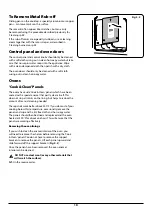
3
Fig. 1.1
Oven care
Use care when opening the door. Let hot air and
steam escape before removing or replacing food
(Fig. 1.1).
NEVER heat unopened food containers. Pressure
build up may make container burst and cause injury.
Keep oven vent ducts unobstructed.
ALWAYS place oven racks in their desired location
while the oven is cool. If a rack must be moved while
the oven is hot, DO NOT let the potholders contact
the heating element in the oven.
Induction care
Important information for pacemaker and implanted insulin
pump users: The functions of this cooktop comply with the
applicable standards on electromagnetic interference. If you
are fitted with a pacemaker or implanted insulin pump and
are concerned please consult your doctor for medical advice.
To fully utilize the power of your induction stove top and
to ensure longevity of performance, we recommend the
use of La Cornue approved Induction Pots and Pans. If you
decide to purchase an alternative set of pans for use on
your induction range, we would strongly recommend that
composite aluminum pans with steel inserts, example shown
Fig. 1.2
, are avoided. This type of pan construction can
significantly reduce the lifetime and performance of your
induction cook top.
Only certain types of glass, glass-ceramic,
earthenware or other glazed containers are suitable
for hotplate cooking; others may break because of
the sudden change in temperature. NEVER cook
directly on the cooktop surface (Fig. 1.3).
DO NOT cook on a broken cooktop. If the cooktop
should break, cleaning solutions and spillovers
may penetrate the broken cooktop and cause a risk
of electric shock. Contact a qualified technician
immediately (Fig. 1.4).
Should a crack appear in the surface, disconnect the
range immediately from the supply and arrange for
its repair.
NEVER leave surface units unattended at high heat
settings - boilover may cause residue, that may ignite.
ALWAYS LIFT pans off the cooktop. Sliding pans may
cause marks and scratches (Fig. 1.5).
Take care NOT TO PLACE HOT LIDS onto the cooktop
surface (Fig. 1.6). Lids that have been used to cover
a hot pan can “stick” or create a “vacuum” effect to
the glass top. Should this occur, DO NOT attempt to
lift the lid off the glass surface, this may damage the
glass. Instead slide the lid to the edge of the cooktop
and remove, taking care not to scratch the cooktop
surface. Alternatively wait until the lid has cooled to
room temperature, the vacuum has been released,
then remove the lid by lifting it from the cooktop.
ArtNo.312-0001 Not cooking surface
ArtNo.312-0003 Moving pans
ArtNo.312-0001 Not cooking surface
Fig. 1.2
Fig. 1.3
Fig. 1.4
Fig. 1.5
Fig. 1.6







































